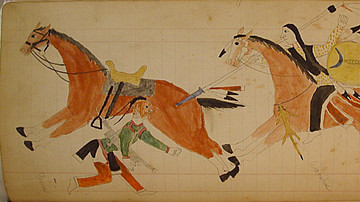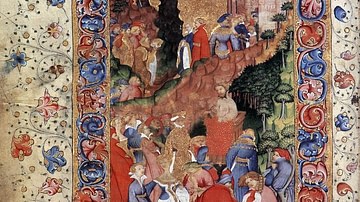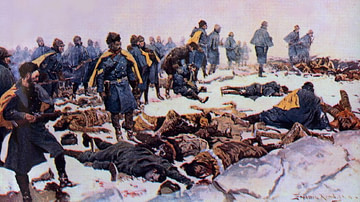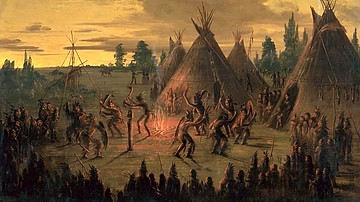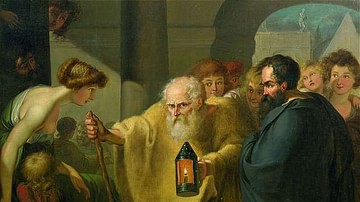The Little Girl and the Ghost is a legend of the Cheyenne nation concerning a young girl abducted by a spirit after she is cast out by her mother. The story explores many themes common in Cheyenne literature, including the importance of following instructions, but it also includes a lesson on the dangers of acting hastily in anger.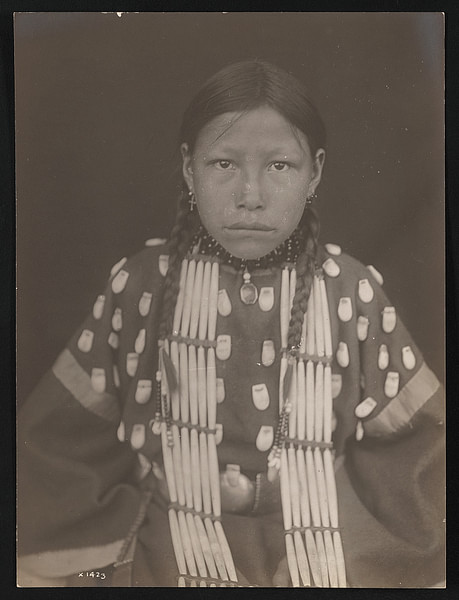
The Cheyenne, like all the Native American nations, place a high value on tradition and faithful observation of the communal rituals, and a significant aspect of this is simply following instructions. In ancient times, at some point, an individual was understood to have received a message from the spirit world instructing them on how to perform a given rite, how to behave with others, how to conduct oneself privately, and how to honor the divine in daily life. These instructions were then shared with others, passed down, and became communal traditions.
For this reason, many Cheyenne tales – if not all of them to one degree or another – emphasize the importance of following instructions. In this, they are no different from the Sioux, the Iroquois, the Pawnee, or any other of the Native peoples of North America, as a common concept they shared was that of the "present past" – how the past is eternally present in the stories one tells and the rituals one observes – but this past can only be present if one is faithful to the original vision of the story and the spirit of the ritual.
There are many different versions of the tales of various Native American nations. There are significant variations on the Cheyenne/Arapaho/Sioux tale How the Turtle Went to War, for example, as well as the Cheyenne stories known as Wihio tales or the Sioux Iktomi tales. The details of these stories do not matter as much as the overall message, the theme, and the moral that is finally the point of the story. Understanding why one is telling the story is an essential aspect of following instructions: one is telling the story, as those who have told it before, because people need to hear what it has to say. The Native American storyteller is only the conduit through which the truths of a given tale are made open to others.
Text
In relating this tale, the storyteller would certainly be emphasizing the cultural importance of obeying instruction, but there are many other aspects to the story that touch on other important lessons. The Cheyenne, like other nations, believe in the reality of ghosts, and many Native American tales deal with the dangers of interacting with these spirits. Among the many dangers ghosts presented was the understanding that they abducted children, especially female children, as food. Ghosts were thought to prey on children as they were more vulnerable than adults. This belief informs The Little Girl and the Ghost as it does so many others, but, here, it serves as a caution against acting hastily in anger.
The mother, tired of hearing her daughter cry and unable to stop the noise, thrusts her angrily from the lodge and, thoughtlessly, yells for a ghost to take her. The mother does not mean this, as is made clear later when she goes crying in search of her missing daughter, but the damage is already done and cannot be undone as the ghost, standing invisibly by, has taken the mother at her word and abducted the girl. The story, then, warns of the consequences of acting in anger: afterwards, it does not matter how sorry one is because what has been done cannot be undone.
Like many Cheyenne tales, the number four is emphasized throughout, as "four" is a sacred number associated with the four cardinal points of the compass. When the old man dresses the young girl to finally return to her people, the storyteller says, "So she was dressed like a Contrary" (159), a reference to the social role known as a Contrary, one who dressed and behaved purposefully in opposition to others in their community, often with the result of awakening in them a clearer understanding of their own behavior. In her role as a Contrary, the main character signals the story should be understood as a call to the audience to examine their own attitudes and conduct.
The following is taken from By Cheyenne Campfires (1926) by George Bird Grinnell, republished in 1971 by the University of Nebraska Press:
There was once a camp and, in one of the lodges, a little girl sat crying; she was angry about something. Her mother did all she could to make the child stop but, at last, the mother became angry, and she opened the lodge door and pushed the child out and said, "Ghost, take away this child!"
A ghost must have been standing somewhere close by the door for, when the mother put the child out, something picked her up. As soon as she was put out, the child stopped crying. After a time, the woman went out and, when she could not find her daughter, she went about among the lodges, crying and looking for her. The one that took away the child was a young ghost and, at the place the young ghost came from, there was an old ghost. The young one brought the child to the old one and said, "Here is your food."
In the morning, the old ghost said to the little girl, "Go and bring in some wood." The little girl went out and gathered some dry wood. A little bird flew close to her and said, "You are getting that wood for yourself" – meaning that it was to be used to cook her. She took the wood up to the lodge and the old ghost looked at it and said, "That is not the kind I want" and sent her to get some more. Again, the little bird said to her, "You are getting that wood for yourself." She took it up to the lodge and, again, the old ghost found fault with it and sent her for other wood. She went a third time and, again, the little bird spoke to her. She was sent back a fourth time. The bird flew close to her and said, "This is the last time; when you go back, they will cook you."
The girl said, "It is useless to tell me that; the big ghost has got me, and I cannot help myself. Can you help me?" The bird answered: "Yes, I can help you. Now, right over here is a mountain peak. I will take you there and, when you get there, you must say at the door in the rock: 'My grandfather, I have come for protection; my father, I have come for protection; my brother, I have come for protection; my husband, I have come for protection.' This must be said at the door. I will take you there. There is a big stone lying against the peak; that is the door."
The bird told her to put a hand on each of its shoulders and, flying close to the ground, it carried her to the peak. When they arrived, the girl repeated what the bird had told her. The bird said, "Place your hand on the rock and push it to one side." She did so and went in and saw an old man sitting there. He said, "Come in, my grandchild. I know you have come to me for protection."
When the old ghost missed the girl, he went out and followed her. He knew she had gone to the peak. As he drew near, he commenced to hoot like an owl; and when he hooted, the ground shook. Four times he hooted and, each time, the ground shook. When the child heard the ghost, she was afraid and ran around inside the lodge, trying to hide; but her grandfather told her to keep quiet and not to be afraid. After hooting four times, the ghost came up to the rock. He stood in front of the door and said, "Bring out my meat! If you will not, I must come in after it." Four times he said that.
The old man said, "Come in and take her out." The ghost said, "Open the door, that I may come in." After he had been asked four times, the old man got up and pulled the door open just far enough for the ghost to get its head in and, when the ghost had put its head in, the old man let the door fly back and cut the head off the ghost so that it fell on the ground inside. The old man picked it up and threw it outside the lodge and said to the girl, "Get some dry wood and throw it over the head."
After she had made a pile over it, the old man set it on fire; then he threw the ghost's body in the fire and handed the girl a stick and said, "Now, if anything rolls out, do not touch it with your hand, but push it back in the fire with this stick." After he had lighted the fire, the head and body cracked open, and pieces of flint and old-time beads rolled out. The little girl wanted to pick them up, but the old man said, "No, push them into the fire." They watched the fire until the ghost was all burned up.
When the girl was seventeen years old, the old man said she might go back to her village. He dressed her like a man; made a robe for her and painted it with Indian red paint; her leggings and moccasins were also painted red. He made her a thunder bow and put buffalo bull tails on the heels of her moccasins. Then he tied the skin of a prairie owl on her forehead. So, she was dressed like a Contrary.
When she was ready to start, the old man gave her a live mink and told her to put it inside her dress on her breast. He said to her:
"You must pass by four villages; stop at none of them; they will call out to you but keep on and pass by. After that, you will find a single lodge. Go in and stop there for, by that time, it will be sundown. At that lodge, you will find an old woman who has great power; she tries to kill everyone who comes to her lodge. When you have gone in, she will boil a kettle of brains and meal for you to eat. The brains will be those of someone she has killed. She will hand you a bowl of this with a horn spoon, but you must not eat it. Feed that to the mink. Then she will cook you some buffalo meat; eat that."
Before the girl left him, the old man told her that, when she stopped at this old woman's lodge, she must not sleep. He said, "If you sleep, she will try to kill you; but, if you do fall asleep, keep the mink up close to your neck and it will act as a guard over you. After she thinks you are asleep, she will begin to scratch her leg and her leg will swell up; then she will use her leg as a club and will strike you on the head with it."
As the girl passed the first village she came to on her journey, the women called out to her, "Come here, young man, and stop" but she paid no attention. When the women found that she paid no attention to them, they called out to her, "You walk like a woman!" This happened at each of the four villages.
Just at sundown, she got to the top of a hill and, down in the valley, saw a lone lodge. The old woman came out and said, "Come down, my grandchild," and took her by the hand and brought her into the lodge. The girl hung her thunder bow on the limb of a tree; then she went in and saw that everything in the lodge looked very fine. The old woman said, "My grandchild must be hungry; I will cook some mush for you." So she put the brains on the fire in a pot. When it was cooked, she gave her a bowl full and a spoon, but the girl fed it to the mink. The old woman said, "My grandchild must be hungry," and began to boil her some buffalo meat and the girl ate that.
After a time, the old woman asked the girl if she was sleepy. She said, "Yes, I would like to go to sleep," and she lay down with the mink up close to her throat. The old woman said, "I will sit up and keep the fire burning so that you will be warm." The girl pretended to sleep and snored, and saw the old woman get up close to the fire and begin to scratch her leg. It began to get larger, and she crawled up to where the girl lay and raised her leg to strike her with it but, just as she held it over her head, the girl pushed the mink out. It caught hold of the woman's leg and tore off a piece of flesh. The old woman cried out, "You have killed me," and fell over; then she began to cry and said, "You have strong spiritual power."
The girl jumped up and went out and, as she did so, picked up a burning brand and set the lodge on fire. She took up her thunder bow and started off in the direction of her camp.
She traveled all that night and, the next day, arrived at the big village. There she stood up on the hill with her thunder bow, and all the village came out to see the strange young man. Two young men came to her and said, "Where did you come from?" She answered, "This is my village; I have been away a long time and have come back."
So, they took her to the center of the camp and called an old man to announce that a young man who belonged to the village had arrived. The old man called it through the village, and everyone came up to look at her. No one knew who she was. Finally, they asked her who her family was.
She hung her head down, for it made her ashamed to remember that her mother had put her out of her lodge. She said she was the girl thrown out of the lodge by her mother and was carried off by the ghost. Then they all recognized her, and her people took her to their lodge.

